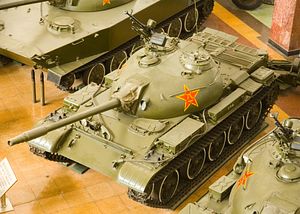In a helpful article last week, my Flashpoints colleague Franz-Stefan Gady makes the compelling case that, contrary to trends in the U.S. military, the armed forces of Asia-Pacific states will continue to build their main battle tank (MBT) arsenal. Across the region, from South Asia to Northeast Asia, MBT counts are on the rise, either through new procurement programs or through scheduled upgrades of existing inventories. Combined, the two largest Asian land armies, India and China, field nearly 10,000 MBTs. As Franz demonstrated, Asian militaries don’t buy that tanks are junk.
Franz’s conclusion that the “MBT will be part of Asian-Pacific military arsenals for a while” is well supported. There is an interesting corollary to the Asia-Pacific’s tank proliferation that helps, in part, answer the question of why Asian states remain interested in acquiring armor: tanks actually will help stabilize escalation and grant strategic malleability to state responses should a conflict arise, particularly between nuclear-armed states. Additionally, Asian states will likely be able to moderate the main weaknesses of the MBT in their expected conflict scenarios.
The MBT is a highly versatile machine of warfare that has historically provided heavy direct fire for armies, allowing infantry and other land forces to gain territorial control in offense scenarios or repel attackers in defensive scenarios. The onset of the armored unit in land warfare created an important step in battlefield escalation that prevented an immediate escalatory leap to more damaging and less discriminate tools of warfare, including nuclear weapons and other heavy ordnance including artillery and aerial bombings.
Although most of Asia’s hottest flashpoints outside of South Asia are in the maritime domain, tanks remain relevant in conventional land war scenarios. The most obvious potential use for MBTs would be in a potential Asian conflict involving India, Pakistan, or China. Both Pakistan and China have, in the past, used MBTs as an important tool of conventional warfare against India — even in the inhospitable terrain of the Himalayan mountain range.
Beyond Asia’s large militaries, the broader proliferation of tanks makes sense given the security needs of states with relatively weaker militaries. Naval and amphibious warfare focused states such as Japan and Indonesia are acquiring new tanks to build capacity in land warfare (urban warfare in Japan’s case). Bangladesh, as a developing nation, is acquiring cheaper Chinese MBTs for similar reasons. None of these states expect to use these tanks for an expeditionary purpose, or even against a foreign invader. MBTs can play an important role in maintaining internal security.
Many of the Asian states acquiring tanks don’t expect to have the MBTs’ weaknesses exploited during conflict and already have the requisite anti-air, surveillance, and infantry units to support armored units. MBTs of the light, medium, heavy and super-heavy types are notoriously vulnerable machines after all. As the United States’ experience in Iraq in the mid-to-late 2000s demonstrated, tanks can fall prey to asymmetrical fighting forces using improvised explosive devices (IEDs) and mines. As a result, states that expect to face asymmetrical insurgencies, for example, are reducing their tank fleets in absolute numbers and focusing instead on acquiring fewer, more advanced tanks. One example of a state following this procurement pattern is Israel.
All this said, the return on investment on MBT acquisitions for most Asian armies seems limited in my view. With the exception of Asia’s three major land powers and South Korea, all of whom face credible land-based conventional military threats, other Asian states are most likely better off investing in anti-access/area-denial (A2/AD) systems and intelligence, surveillance, and reconnaissance (ISR) systems. One example of a state that should be doing this is Taiwan, which is considering upgrading its aging fleet of 450-some tanks with the United States’ M1A1 Abrams. Not only are M1A1s problematic given Taiwan’s existing road and bridge infrastructure, the island’s main threats mainly come by sea and air from across the Taiwan Strait (though M1A1s could be a good answer to the PLA’s growing mechanized infantry divisions).
The world’s foremost military power, the United States, seems to think tanks are bit passé. Indeed, reading the Pentagon’s new third offset strategy, tanks seem like an archaic vulgarity, unfit for any role on the modern battlefield. The U.S. might be ahead of the curve, but Asian militaries don’t buy that MBTs are simply biding their time on the technological obsolescence curve.































